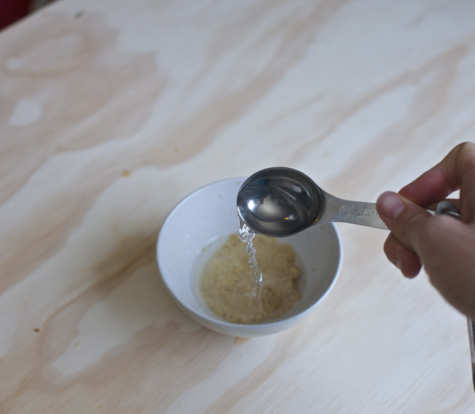

Vegan baking can initially seem intimidating, but really, it’s not so different from the standard procedure that you probably grew up on. For the most part it’s just a simple series of 1:1 substitutions, like plant milk for dairy milk and vegan butter for dairy butter.
And eggs? What of them?
In vegan cookbooks everywhere, and all across the Internetz, you’ll find recipes referencing “flax eggs”. Sometimes they’re actually even written as components, for example “1 tbsp flax meal + 3 tbsp water”. Which seems pretty self explanatory, right? You’d think!
But nope, if you want your flax to really approximate eggs – to really achieve that gelatinous, goopy goodness that works so very well as a binder (especially important in gluten-free recipes!) – then it helps to have a few tricks hidden in your pastry case. I’ve been baking exclusively vegan for a while now, and this is how I guarantee the perfect flax egg, every time:
 1.
1.
Begin with whole, raw flax seeds. Buying pre-ground flax is a dangerous game, as the oil is very unstable, and once released (via grinding) it will turn rancid pretty quickly. So buy your flax seeds whole and grind them yourself, to spec. It’s easy enough; you can use a coffee grinder, a hand-crank spice grinder, a mortar and pestle, or a high-speed blender. Process into a very fine powder.
Store whole flax seeds in the refrigerator or freezer.
 2.
2.
Make egg/s. One egg equals [1 tablespoon flax meal plus 3 tablespoons water], and you do not need to make each one individually. In a small bowl, add flax meal followed by water (not water followed by flax), stirring as you go. I use a miniature whisk because it’s adorable, but a fork works just as well.
 3.
3.
Refrigerate. This is key! Place the bowl of eggs in the refrigerator for a minimum of 15 minutes, but up to an hour is best. This will allow your egg to “set up”. Don’t skip this important step!
I always make my eggs at the start of a recipe. That way, I can get them in the fridge, and then work through the other steps while the eggs set.
 4.
4.
When the eggs come out of the fridge they’ll have formed a thick sticky goo, just the consistency of egg whites. There’s your binder! Add it to the recipe and proceed as instructed.
Note: Flax has a nutty, somewhat distinctive flavor. It’s pretty well masked in recipes such as whole wheat breads, spice loafs, and other “full-bodied” treats. But for something like white cake or sugar cookies, you may notice the flavor. If this bothers you, try using chia seeds instead! They work just the same and don’t add any flavor (though admittedly, they cost about four times as much).





Pingback: Think Cupcakes Aren’t Healthy? These Will Knock Your Socks Off. | Live Well, and Feel Great
Pingback: Vegan Substitute For Eggs When Baking | We Get Healthy
Pingback: Modifying Recipes for Allergies or Intolerances | Blog
Pingback: Baking Vegan Substitute For Eggs | We Get Healthy
Pingback: Easy Cornbread Muffins - Baby Led Weaning Ideas
Pingback: Brown Butter Snickerdoodles | Megatarian
Pingback: Coconut Flour Chocolate Chip Cookies (with pumpkin seeds!) | The Gluten Free Actress
Pingback: Meat & veggie burgers | The Angry Hungry Hobbit
Pingback: Buckwheat Muffins With Banana, Avocado and Apple | The Glow Within
Pingback: Coconut lime cake | Rhubarb and Strawberry
Pingback: Napoli Soul Food: Vegan Casatiello or Neapolitan Stuffed Easter Bread | Emi's Good Eating
Pingback: Sourdough Blueberry Pancakes
Pingback: Fugdy Brownie Bites – ROETHLISBERGER
Pingback: Glutenfria Pitabröd – ROETHLISBERGER
Pingback: Svar på läsarfråga; hur vegananpassar man recept innehållandes ägg/vassle/kasein? – ROETHLISBERGER
Pingback: Vegan Baked Blueberry Oatmeal | Kale, Karma, & Kettlebells
Pingback: Applesauce Cake! |
Pingback: Think Cupcakes Aren’t Healthy? Think Again! | Live Well, and Feel Great
Pingback: Vegan Black Bean Brownies | Lindy Lu Reviews
Pingback: In lieu of the pie… | Hobbits At Home
Pingback: Rhubarb quinoa baked oatmeal - Roots & Wren
Pingback: Easy And Creative Uses For Flaxseeds | Get Fresh SD
Pingback: Fudgy Grain-Free High-Protein Brownies (veg/v option) | RD-Licious
Pingback: Episode 5: How to Eat a Vegan Breakfast | Eco-Vegan Pal
Pingback: Fugdy Brownie Bites – Roethlisberger.se
Pingback: Svar på läsarfråga; hur vegananpassar man recept innehållandes ägg/vassle/kasein? – Roethlisberger.se
Pingback: A Vegan Guide to 13 Unusual Ingredients in Plant-Based Recipes
Pingback: Glutenfria Pitabröd – Roethlisberger.se
Pingback: Τηγανίτες βατόμουρου με προζύμι - Ιστολόγιο